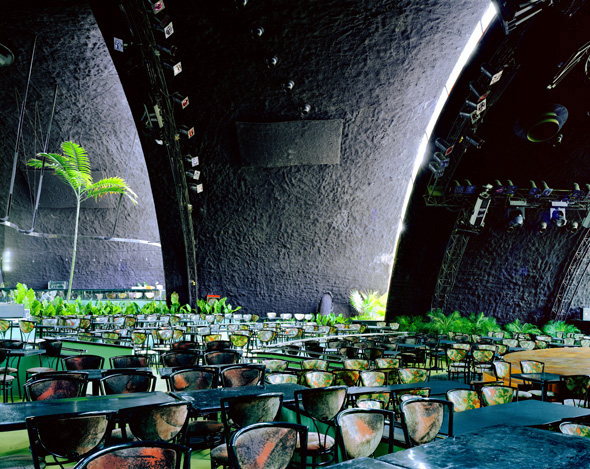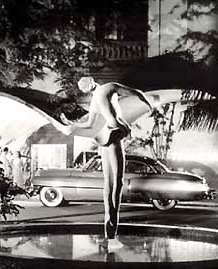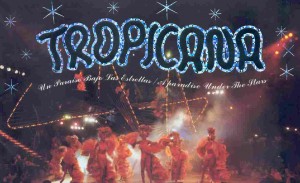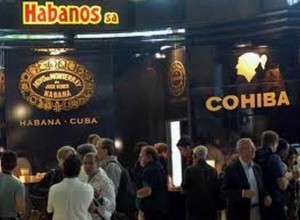The Tropicana NightClub in Havana recaptured its glamour by the hand of the Cuban cigar.
On the night of January 31, 1939, while Europe was cultured and old days of war, misery and uncertainty, grieving with the threat of being crushed by the Nazi hegemony in a wooded aristocratic fifth of Marianao neighborhood in the outskirts of Havana, 300 people gave off the year enjoying carefree and happily, enraptured by the best music of the tropics, most exquisite drinks, the most beautiful women and the most sought after blue smoke cigars, grown in the Vuelta Abajo. That memorable night, those attending the inauguration developed a bold outdoor cabaret intended, since then, reaching the supremacy of night spots in the capital of the Pearl of the Antilles.
Tropicana, which was born as an impossible dream sprouted amid the dense vegetation of an old and aristocratic pleasure house called Villa Mina, would exceed your initial bet soon to become not only the most quoted of Havana cabarets, but in “the night club more attractive and sumptuous world, “rival Parisian Red Mill and Broadway musicals. His first launched its bid promoters and achieved rapid aggrandizement of local appeal thanks to the magic combination of several essential elements: from the weather and the music of the island, to the imponderable beauty of his famous and well made mulatto singers, through the exquisite cuisine and liquor, but, above all, by the ingenuity of art directors and choreographers who converted their benchmark scenario in terms of artistic quality cabaret show of all time.
Such was the success of Tropicana along the bellicose 40s, its owners decided to expand their capacity, while tripling the number of tables in the now famous show “Under the Stars”, they decided to append an indoor location, ready for rainy nights. Known from then on as “Arcos de Cristal”, the new stage was so bold and elegant design which won the awards of the College of Architects of Cuba and captivated visitors with its play of lights, shapes and integration to the whole nature of place. Also, for the time, the facility had also casinos and restaurants that diversified entertainment options and the thousands of tourists each year who went through the installation Havana, in which more than one night met such emblematic of the Havana at the time as no doubt they were Meyer Lansky, Santos Trafficante and other “bosses” of the game and pleasure, dressed in fine linen suits, and displaying a splendid and smoking cigar on the lips.
Tropicana, rather than being under the stars, had thrown them, and has since passed through its stage the greatest luminaries of Cuban music – the incomparable Rita Montaner, an extraordinary percussionist Chano Pozo, the incomparable crooner Snowball, the kings of country music and Reutilio Celina – and some of the most famous personalities of world art – Nat King Cole, Carmen Miranda, Josephine Baker, Xavier Cugat and his orchestra, and many others who made memorable nights of pleasure and habanero delirium.
Neither the political violence that takes over Cuba in the ’50s, or the economic and social changes in the country since the coming to power of Fidel Castro and his rebel troops, could devastate the brightness glamorous Tropicana, which in its more than 60 years of life has been able to maintain, even in the midst of the toughest economic conditions without some of their old attractions – the casinos, for example – spectacular cabaret sense faithful to a tradition, a style and a patented definitely atmosphere in their glorious 50s, when deservedly won the title of “paradise under the stars”.
However, the severe economic crisis of the 90s Cuban and some retrograde morality were about to liquidate a tradition that seemed immovable. In years of multiple deprivation, the thousands of lights might seem a waste cabaret, the elegant designs shows an unnecessary expense and the scantily clad showgirls in some numbers an affront to Cuban women and socialist, even though lights , shows and lush guaranteed women the juicy profits every night. But while the country was peopled bicyclist, darkened in long nights of blackouts and food became a daily drama, Cuba decided to offer the world as a new tourist destination and commercial, in this way, came the salvation of Tropicana.
Perhaps the turning point in the revitalization of the old cabaret who refused to grow old, came the night of February 28, 1996, and caused one of the most important in the history of Cuba: the snuff.
That was, in the words of the witnesses, the most glamorous night lived in Cuba since 1959: 700 people, many of them Americans, atraviados with tuxedos and long gowns, besieged by photographers and journalists as an Oscar award, Tropicana packed dinner convened by which clausuraban the festivities for the 30th anniversary of the flagship brand of Cuban cigars, the Cohiba recognized. Something unusual in a country that had lived more than three decades of socialism happened in the former “sexiest night club and sumptuous in the world”, when those lovers of good smoke bid for several lots of Cuban cigars to pay the amount of 342 000 dollars, 130 000 of which were used to purchase a box of 90 cigars, signed by Fidel Castro and illustrated by Ecuadorian painter Oswaldo Guayasamin …
Tropicana and the cigar were that night to begin a spectacular and warm love story – could not be otherwise – between two emblems of life and culture of Cuba.
Since then, every February “paradise under the stars” dinner made final and grand auction of what has been dubbed the Festival del Habano.
A must for the discerning smokers and businessmen loftiest related to the production and sale of Cuban cigars in the world, the Festival del Habano is the grand meeting dedicated to the art and pleasure of smoking. The multiple brands and 700 formats and twisted tobaccos grown in Cuba Tropicana live in their big day of glory, and from year to year auctions figures go up by as extraordinary as the $ 607,000 raised in 2001 by party auction of eight lots of cigars and … mythical hat and smoking Cuban musician Compay Segundo, who was acquired for 17 1500 greenbacks … like the tabaco.
Sources: LeonardoPadura/Excerpt/Internetphotos/www.thecubanhistory.com
THE TABACO FESTIVAL in Havana which saved the “Tropicana NightClub”.
The Cuban History, Arnoldo Varona, Editor
EL FESTIVAL DEL TABACO QUE SALVO AL “CABARET TROPICANA” HABANERO.
El cabaret Tropicana reconquista su glamour de la mano del puro cubano.
La noche del 31 de enero de 1939, mientras la culta y vieja Europa vivía días de guerra, miseria e incertidumbre, desconsolada con la amenaza de ser aplastada por la hegemonía nazi, en una aristocrática y arbolada quinta de la barriada de Marianao, en las afueras de La Habana, 300 personas despedían el año disfrutando despreocupada y alegremente, arrobadas por la mejor música de los trópicos, las bebidas más exquisitas, las más bellas mujeres y los más cotizados puros de humo azul, cultivados en las vegas de Vuelta Abajo. Esa noche memorable, aquellos adelantados asistían a la inauguración de un osado cabaret al aire libre que pretendía, desde entonces, alcanzar la supremacía de los lugares de diversión nocturna de la capital de la Perla de las Antillas.
Tropicana, que nacía como un sueño imposible brotado en medio de la tupida vegetación de una antigua y aristocrática casa de recreo conocida como Villa Mina, pronto rebasaría su apuesta inicial para convertirse no ya en el más cotizado de los cabarets habaneros, sino en “el night club más atractivo y suntuoso del mundo”, rival de los Molinos Rojos parisinos y de las revistas musicales de Broadway. Sus primeros promotores lanzaron su apuesta y lograron el rápido encumbramiento del atractivo local gracias a la conjunción mágica de varios elementos imprescindibles: desde el clima y la música de la isla, hasta la belleza imponderable de sus famosas y bien hechas coristas mulatas, pasando por la exquisita oferta gastronómica y licorera, pero, sobre todo, por el ingenio de directores artísticos y coreógrafos que convirtieron su escenario en punto de referencia en cuanto a la calidad artística del espectáculo de cabaret de todos los tiempos.
Tal fue el éxito de Tropicana a lo largo de la belicosa década del 40, que sus propietarios decidieron ampliar su capacidad y, mientras triplicaban el número de mesas en el ya famoso salón “Bajo las Estrellas”, decidían anexar un local bajo techo, dispuesto para noches de lluvia. Conocido desde entonces como “Arcos de Cristal”, el nuevo escenario tenía tan atrevido y elegante diseño que mereció los premios del Colegio de Arquitectos de Cuba y cautivó a sus visitantes con sus juegos de luces, formas y la integración al conjunto de la naturaleza del lugar. Además, para aquella época, la instalación contaba también con casinos de juego y restaurantes que diversificaban opciones y entretenimientos a los miles de turistas que cada año pasaban por la instalación habanera, en la que más de una noche se dieron cita personajes tan emblemáticos de La Habana de la época como sin duda lo fueron Meyer Lansky, Santos Trafficante y otros “capos” del juego y el placer, ataviados con finos trajes de hilo, y exhibiendo un espléndido y humeante habano en los labios.
Tropicana, más que estar bajo las estrellas, se había lanzado hacia ellas, y desde entonces pasaron por su escenario las más grandes luminarias de la música cubana – la inigualable Rita Montaner, el extraordinario percusionista Chano Pozo, el incomparable chansonier Bola de Nieve, los reyes de la música campesina Celina y Reutilio – y algunas de las más célebres personalidades del arte mundial – Nat King Cole, Carmen Miranda, Josephine Baker, Xavier Cugat y su orquesta, y tantos otros que hicieron memorables las noches de placer y delirio habanero.
Ni la violencia política que se apodera de Cuba en los años 50, ni los cambios económicos y sociales que vive el país desde la llegada al poder de Fidel Castro y sus tropas rebeldes, pudieron devastar el glamoroso brillo de Tropicana, que en sus más de 60 años de vida ha logrado mantener, incluso en medio de las más duras condiciones económicas y sin algunos de sus viejos atractivos –las salas de juego, por ejemplo–, su sentido de cabaret espectacular fiel a una tradición, un estilo y una atmósfera definitivamente patentada en sus gloriosos años 50, cuando merecidamente conquistó el título de “paraíso bajo las estrellas”.
Sin embargo, la dura crisis económica cubana de los años 90 y cierta moralidad retrógrada estuvieron a punto de liquidar una tradición que ya parecía inamovible. En años de carencias múltiples, las miles de luces del cabaret podían parecer un derroche, los elegantes diseños de los espectáculos un gasto innecesario y la escasa vestimenta de las coristas en algunos números una afrenta a la mujer cubana y socialista, a pesar de que luces, espectáculos y mujeres exuberantes garantizaban las jugosas ganancias de cada noche. Pero mientras el país se poblaba de bicicletas chinas, se oscurecía en noches de largos apagones y la comida se convertía en un drama diario, Cuba decidía ofrecerse al mundo como nuevo destino turístico y comercial y, por esta vía, llegó la salvación de Tropicana.
Quizás el giro decisivo en la revitalización del viejo cabaret que se negaba a envejecer, llegó la noche del 28 de febrero de 1996, y lo provocó uno de los personajes más importantes en la historia de Cuba: el tabaco.
Aquella fue, al decir de los testigos, la noche de más glamour vivida en Cuba desde 1959: 700 personas, muchos de ellos norteamericanos, atraviados con tuxedos y largos trajes de noche, asediados por fotógrafos y periodistas como en una entrega de premios Oscar, abarrotaron Tropicana convocados por la cena con que se clausuraban las festividades por el 30 aniversario de la marca insignia de los puros cubanos, la reconocida Cohiba. Algo inusual en un país que había vivido más de tres décadas de socialismo real sucedió en el otrora “night club más atractivo y suntuoso del mundo”, cuando aquellos amantes del buen fumar pujaron por varios lotes de puros cubanos hasta pagar la cifra de 342 mil dólares, 130 mil de los cuales fueron destinados a la adquisición de una caja de 90 habanos, firmada por Fidel Castro e ilustrada por el pintor ecuatoriano Oswaldo Guayasamín…
Tropicana y el habano se encontraban aquella noche para iniciar una espectacular y cálida historia de amor – no podía ser de otro modo – entre dos emblemas de la vida y la cultura cubanas.
Desde entonces, cada mes de febrero el “paraíso bajo las estrellas” efectúa la cena final y la gran subasta de lo que ha sido bautizado como el Festival del Habano.
Cita obligada para los más exigentes fumadores y los más encumbrados hombres de negocios relacionados con la producción y la venta de los puros cubanos en el mundo, el Festival del Habano es el gran encuentro dedicado al arte y el placer de fumar. Las múltiples marcas y los 700 formatos de tabacos cultivados y torcidos en Cuba viven en Tropicana su gran día de gloria, y de año en año las cifras de las subastas suben hasta niveles tan extraordinarias como los 607 mil dólares recaudados en la fiesta del 2001 por la subasta de ocho lotes de puros y… el sombrero del mítico músico y fumador cubano Compay Segundo, que fue adquirido por 17 mil quinientos billetes verdes… como el tabaco.
Sources: LeonardoPadura/Excerpt/Internetphotos/www.thecubanhistory.com
THE TABACO FESTIVAL in Havana which saved the “Tropicana NightClub”.
The Cuban History, Arnoldo Varona, Editor







